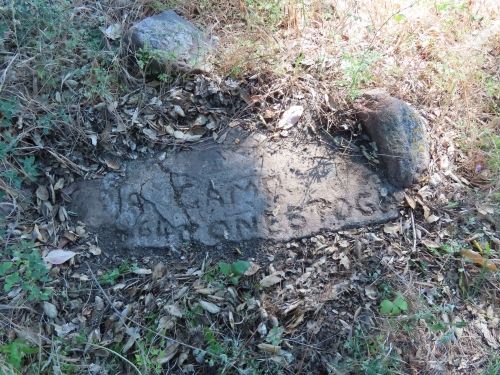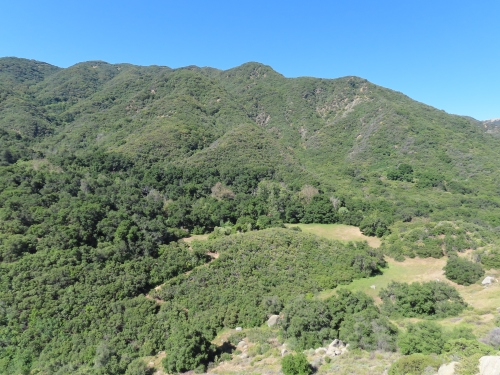Forbush Flats is a trail camp located along North Cold Spring Trail on the backside of the Santa Ynez Mountains. The camp has two sites tucked in under the oaks and conifers, next to a seasonal creek. Nearby, is a horseshoe-shaped meadow that’s framed by a small ridge.
When I first wrote about the camp in an article, a reader informed me that the cedar trees at one of the campsites were actually planted by students from Camp Conestoga.
On a subsequent visit to the camp, I took some extra time to appreciate the cedars and was encouraged to see a number of smaller trees growing there, descendants of those planted by the students.
Close by, underneath an oak tree, I noticed several stones peaking out from beneath the leaves that seemed a little too linear in their arrangement; curious I bent down and began brushing away the leaves and discovered the cement foundation for an ice can stove. The stove had long since been removed, but the foundation was still intact and written in the concrete were the words Camp Conestoga.

Cement stove foundation with the words Camp Conestoga
When I got home I began researching the name and eventually discovered Camp Conestoga was started by Frank Van Schaik, a schoolteacher at Wilson Elementary School, who also wrote a column for the News-Press back in the early 1960s. In fact, the best resource describing the program is Van Schaik’s book, Home of the Wilson Wildcats – Life and Death of an American Elementary School.
The oldest of four brothers, Frank Van Schaik graduated from Stanford University and, in 1936, moved to Santa Barbara where he began teaching fifth and sixth grade at Wilson Elementary School. The neighborhood school was located along Castillo Street, between Victoria and Anapamu Streets, where the Westside Community Center is now.
Wilson School is also where Van Schaik met his wife Lois, who taught second grade. Together they built a house in Rattlesnake Canyon using redwood from his parents’ property in Marin County, and sandstone from their own property.
During the summers, he would take some of the students to his parents’ property and camp amongst the redwoods. That first group of kids called themselves the Dusty Oysters, a whimsical name that likely came from the works of Lewis Carrol. It was through these campouts that he saw the benefits of what we would now call outdoor education.
During the war years, with gas rationing and higher fuel costs, Van Schaik needed a place to offer outdoor programs that was closer to home. In 1944, he reached out to the City Recreation Department and started a summer day camp program at Anapamu Park, located where Bohnett Park is now, at the corner of Anapamu and San Pascual Streets, that became Camp Conestoga.
Back then, the westside was less developed and the park covered close to two city blocks. Before Highway 101 was built, and the course of Mission Creek was shifted to follow the freeway, Mission Creek flowed through the park, creating a rustic setting ideal for outdoor learning. Although now smaller, Bohnett Park still retains some of these scenic features.
At Camp Conestoga, kids participated in a variety of outdoor activities, made real bows and arrows, tanned animal hides, took care of pack animals that had been donated to the cause, practiced knot tying, and learned what might be described today as homesteading or ranching skills combined with outdoor skills. As the program grew there was a craft shop and chuck wagon kitchen that students participated in.
Early on, Frank Van Schaik was helped by his brother Bill, who was a student at UCSB, and later became at teacher at Franklin Elementary School. Bill was to Franklin School, what Frank was to Wilson School, in terms of the lasting impact he had on the students there. As the program continued and grew, several former students from Wilson and Camp Conestoga became part of the staff.
In 1947, the Junior League of Santa Barbara began sponsoring the program, and through their generous funding the camp was able to buy camping gear and supplies, as well as purchase a truck. They also now had a budget for food and gas, which allowed the program to expand where they could take kids on outings, both locally and to the Sierras.
The valuing of outdoor education was all just part of Van Schaik’s approach to learning. Without any specific theory on education, he just understood that kids learn best through experience, and that engaging the senses and doing hands on work can build lasting knowledge and confidence.
This same approach held true in the classroom. Students were involved in a wide variety of activities that gave them hands on experience.
Van Schaik’s other true passion beside teaching and the outdoors, was Democracy. Each year his students would craft a class constitution and live by it. He saw to it that there were ample opportunities for students to take on leadership roles and learn how to work together. To learn how to manage their own affairs and respect one another.
He believed that it was the responsibility of a democratic society, through its schools, to give children the skills, knowledge, and character, to govern themselves and to vote wisely, in order for democracy to succeed.
Writing was also an important part of the classroom. Students would practice writing everyday, not as a rote activity, but as something rooted in observation and self reflection.
He had students write about what they felt, the things they strongly liked or disliked, to learn how to express what mattered most to them. They wrote about their outdoor experiences, and also kept a daily journal. In class, they wrote stories and poetry that were collected into pamphlets produced by the students.
Almost every activity was an enriching experience the kids could learn and grow from. Each day, time was set aside for lively discussions on current events. The students produced a class newspaper. They hosted nature fairs in their classroom, crafting exhibits and sharing them with the other classes. Elaborate masks were made for Halloween. Ceramics and woodworking were part of their activities. Students were even in charge of how the classroom was decorated.
Similarly, Camp Conestoga not only gave them hands on experiences, but also took them on many memorable trips, camping and backpacking in the Sierras, and even a trip to the Grand Canyon. Locally, they visited places along the coast and in the Santa Barbara backcountry, including trips to Figueroa Mountain, Manzana Creek, and the Sisquoc River.
On one particular trip to Forbush Flats, shortly after the group arrived and set up their bedrolls in the meadow, a bear that had been startled by all the activity dashed through the bedrolls and charged up the creek to the delight and amazement of the students. From then on the place was referred to as Bear Meadow.

“Bear Meadow” Forbush Flats
In 1951, Dick Smith, who wrote for the Santa Barbara News-Press, joined them on a camping trip to P-Bar Flat along the upper Santa Ynez River and wrote a feature that appeared in the Sunday paper.
Smith later encouraged Van Schaik to write a column for the News-Press. From 1960-1962, Van Schaik wrote Nature Walks; the column featured articles about the natural history of the Santa Barbara region. He also co-authored two books with Smith about our local area, Santa Barbara Backcountry and Beach Walker’s Guide.
In 1962, Van Schaik became the principal at Wilson, which is probably what ended the column. As principal, he strove to bring in the best teachers he could find who brought with them a similar passion for teaching. He had each class elect a student representative, that collectively wrote a constitution for the school.
In 1970, Frank Van Schaik retired as principal of Wilson Elementary School, after 44 years of being actively involved with the school. Several years later Camp Conestoga came to a close.
In 1992, his former students and Camp Conestoga alumni organized a reunion for his birthday at Skofield Park. As part of the gathering, the meadow on the north side of creek was dedicated as Van’s Meadow. A sandstone boulder with a metal plaque commemorates the occasion. Nearby, is a bench honoring his wife who passed away in 2001. Frank Van Schaik passed away in 2006.
The meadow dedicated in his honor is located across the creek from the main part of the park, and used to be reached by a set of stairs that lead down to the creek. The lower portion of the stairs were washed out during a storm and the route is now closed. However, the meadow can still be reached from Las Canoas Road, along an unpaved access road that starts near the driveway that used to lead to St. Mary’s Seminary.
In some ways it’s now a hidden meadow, just as the oak leaves keep covering up the stone foundation for the stove at Forbush Flats, waiting to be rediscovered by someone curious enough to look for it.
But Frank Van Schaik’s legacy lives on in the lives of those he worked with, the students he taught, and the difference he made in his local community. A gift of presence that is far more lasting.
This article originally appeared in section A of the June 24th, 2019 edition of Santa Barbara News-Press.










Great article, James!!
Mike Dillenback HPS Chair
>
By: Michael Dillenback on July 27, 2019
at 7:06 pm
Fascinating read! Thank you James.
By: Carol Brown on July 28, 2019
at 12:23 pm
I was privileged to have Van as my sixth-grade teacher in 1949. I’m still friends with two of my best sixth-grade buddies. All three of us were greatly influenced by Van, and became good responsible men, with excellent work ethics because of Van. The last time I saw Van was when the three of us took him to lunch at his favorite spot; Joe’s restaurant on State Street. Van was in his 90s at the time.
Frank Van Schaik, Wilson grammar school, and room 10 will live in the hearts of many all of their lives. We are Dusty Oysters to the man.
By: Frank Pernice on August 25, 2019
at 7:44 am
Frank, great to hear from you. So many people benefitted from what Van brought. Wish I’d had the chance to meet him.
By: James Wapotich on August 25, 2019
at 9:33 am